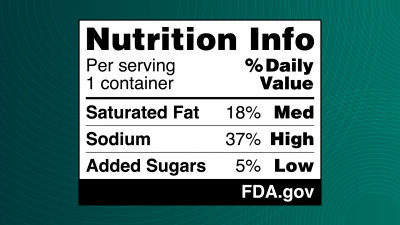The U.S. Food and Drug Administration (FDA) has unveiled a proposal to introduce mandatory front-of-pack (FOP) nutrition labelling for most packaged foods, aiming to make nutritional information more accessible and easier to understand for consumers. The proposed “Nutrition Info box” focuses on three critical nutrients—saturated fat, sodium, and added sugars—presenting their levels as “Low,” “Med,” or “High.” This straightforward labelling system is designed to empower individuals to make informed dietary choices at a glance.
This initiative is part of broader efforts to combat diet-related chronic diseases, which are among the leading causes of death and disability in the United States. Notably, these conditions disproportionately affect minority communities and individuals with lower socioeconomic status, making clear and accessible labelling a public health priority.
Key Features of the Nutrition Info Box
The proposed FOP label categorizes the content of saturated fat, sodium, and added sugars in a serving of food as “Low,” “Med,” or “High.” These indicators provide an easy-to-understand context for consumers who might not regularly engage with the more detailed Nutrition Facts label found on the back or side of packages.
Interestingly, the box excludes calorie counts, though manufacturers can include voluntary calorie statements on the front of packages under existing regulations.
The FDA’s approach shares similarities with FOP labeling systems in Europe, but there are key differences.

Comparing the FDA’s Proposal to Nutri-Score
The FDA’s proposed system bears similarities to the Nutri-Score, a front-of-pack labelling system widely adopted in Europe, yet there are important differences:
- Label Format:
- Nutri-Score: Uses a five-colour scale, ranging from green (healthiest) to red (least healthy), combined with a letter grade (A to E) to indicate the overall nutritional quality of a product.
- Nutrition Info box: Adopts a black-and-white format and does not provide an aggregate score or colour-coded indicators. Instead, it focuses solely on individual levels of saturated fat, sodium, and added sugars.
- Nutrient Scope:
- Nutri-Score: Balances both positive and negative attributes, factoring in fibre, protein, and healthy fats, alongside nutrients like sugar, saturated fat, and salt.
- Nutrition Info box: Concentrates exclusively on nutrients typically overconsumed in the U.S. diet—saturated fat, sodium, and added sugars—based on federal dietary recommendations.
- Consumer Understanding:
- European labels often rely on visual cues like colours to engage consumers visually.
- The FDA’s scheme emphasizes clarity and interpretability through explicit “Low,” “Med,” and “High” designations, based on percent Daily Value.
- Implementation Timeline:
- European systems are already widely adopted many countries, with Nutri-Score being the most widely used across Europe but on a voluntary basis.
- The FDA’s proposal outlines a phased compliance timeline: three years for larger businesses and four years for smaller ones.
The Science Behind the Proposal
The FDA conducted extensive research to ensure the efficacy of the proposed label. A peer-reviewed experimental study and focus group testing revealed that a black-and-white design, paired with interpretive percent Daily Value indicators, was the most effective in helping consumers identify healthier options. This mirrors international findings that FOP labelling systems improve consumer understanding and promote healthier choices.
Potential Impact
The Nutrition Info box has the potential to empower millions of U.S. consumers to make healthier dietary choices, particularly those in demographic groups with lower engagement with existing Nutrition Facts labels. By providing clear, concise, and actionable information, the FDA aims to tackle the public health crisis of diet-related chronic diseases.
Statement from the President of the Academy of Nutrition and Dietetics
Harlivleen “Livleen” Gill, MBA, RDN, LDN, FAND, President of the Academy of Nutrition and Dietetics, responded to the FDA’s proposed labelling changes:
“The FDA’s new standardised front-of-package nutrition labelling will make key nutritional information more accessible, helping consumers make healthier choices. While this marks progress, it’s important to remember that health is individual. Registered dietitian nutritionists (RDNs) consider personal factors such as age, lifestyle, and health history to offer tailored advice. As the FDA implements these changes, RDNs will continue to support nutrition literacy and help consumers make informed dietary decisions.”
Moving Forward
The FDA is accepting public comments on the proposed rule through 16 May 2025, via Regulations.gov. If adopted, the rule would allow businesses a phased compliance period, enabling a smooth transition.
Conclusion
The FDA’s proposed Nutrition Info box aligns with international efforts, such as Nutri-Score, to improve public health through clear and accessible labelling. While Nutri-Score provides a comprehensive, colour-coded overview of nutritional quality, the U.S. approach prioritises simplicity and interpretability, focusing on nutrients most relevant to American dietary challenges. Both systems highlight the importance of empowering consumers with the information needed to make healthier food choices.
For more information:
Explanatory Video and Examples from FDA
https://www.fda.gov/food/nutrition-food-labeling-and-critical-foods/front-package-nutrition-labeling

